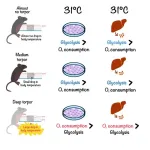(Press-News.org) The largest ever study of the genetics of the brain – encompassing some 36,000 brain scans – has identified more than 4,000 genetic variants linked to brain structure. The results of the study, led by researchers at the University of Cambridge, are published in Nature Genetics today.
Our brains are very complex organs, with huge variety between individuals in terms of the overall volume of the brain, how it is folded and how thick these folds are. Little is known about how our genetic make-up shapes the development of the brain.
To answer this question, a team led by researchers at the Autism Research Centre, University of Cambridge, accessed MRI scans from over 32,000 adults from the UK Biobank cohort and over 4,000 children from the US-based ABCD study. From these scans, the researchers measured multiple properties of the outermost layer of the brain called the cortex. These included measures of the area and volume of the cortex as well as how the cortex is folded.
They then linked these properties, measured both across the entire cortex as well as in 180 individual regions of the cortex, to genetic information across the genome. The team identified over 4,000 genetic variants linked to brain structure.
These findings have allowed researchers to confirm and, in some cases, identify, how different properties of the brain are genetically linked to each other.
Dr Varun Warrier from the Autism Research Centre, who co-led the study, said: “One question that has interested us for a while is if the same genes that are linked to how big the cortex is – measured as both volume and area – are also linked to how the cortex is folded. By measuring these different properties of the brain and linking them to genetics, we found that different sets of genes contribute to folding and size of the cortex.”
The team also checked whether the same genes that are linked to variation in brain size in the general population overlap with genes linked to clinical conditions where head sizes are much larger or smaller than the general population, known as cephalic conditions.
Dr Richard Bethlehem, also from the Autism Research Centre and a co-lead of the study, said: “Many of the genes linked with differences in the brain sizes in the general population overlapped with genes implicated in cephalic conditions. However, we still do not know how exactly these genes lead to changes in brain size.”
Dr Warrier added: “This work shows that how our brain develops is partly genetic. Our findings can be used to understand how changes in the shape and size of the brain can lead to neurological and psychiatric conditions, potentially leading to better treatment and support for those who need it.”
This study was supported by the Wellcome Trust. It was conducted in association with the NIHR CLAHRC for Cambridgeshire and Peterborough NHS Foundation Trust, and the NIHR Cambridge Biomedical Research Centre.
Reference
Warrier, V et al. Genetic insights into human cortical organisation and development through genome-wide analyses of 2,347 neuroimaging phenotypes. Nat Gen; 17 Aug 2023; DOI: 10.1038/s41588-023-01475-y
END
Largest genetic study of brain structure identifies how the brain is organised
2023-08-17
ELSE PRESS RELEASES FROM THIS DATE:
Discovery of chikungunya virus’s “invisibility shield” may lead to vaccines or treatments
2023-08-17
August 17, 2023—(BRONX, NY)—Researchers at Albert Einstein College of Medicine have found that the virus responsible for chikungunya fever can spread directly from cell to cell—perhaps solving the longstanding mystery of how the virus, now emerging as a major health threat, can manage to escape antibodies circulating in the bloodstream. The findings, published today in Nature Microbiology, could help in developing effective vaccines or treatments for chikungunya fever, a debilitating and increasingly common mosquito-borne disease.
A Possible Explanation ...
Immunotherapy drug combo helps extend the lives of patients with metastatic melanoma
2023-08-17
A research team co-led by UCLA investigators has shown that an immunotherapy drug combination can be an effective second-line therapy for patients with an aggressive and deadly type of melanoma that is resistant to the widely used immunotherapy drugs known as PD-1 inhibitors.
In clinical trials, the investigators found that the combination therapy can extend the amount of time patients live without their cancer worsening, known as progression-free survival, and helps overcome resistance to prior immunotherapies, allowing more patients to benefit from the treatment.
The ...
Towards organ preservation: Animal resistance to cold reflected in stem cells
2023-08-17
Researchers led by Genshiro Sunagawa at the RIKEN Center for Biosystems Dynamics Research (BDR) in Japan have shown that an animal’s stem cells possess the same level of cold resistance as the animal itself. Published August 17 in Cell Reports, the study focuses on mice with different hibernation-like characteristics, showing that those with the best resistance to cold temperatures have stems cells that generate energy differently than others. Beyond these immediate findings, the study establishes mouse stem cells as a practical model ...
Anti-obesity drug improves associative learning in people with obesity
2023-08-17
To control our behaviour, the brain must be able to form associations. This involves, for example, associating a neutral external stimulus with a consequence following the stimulus (e.g., the hotplate glows red - you can burn your hand). In this way, the brain learns what the implication of our handling of the first stimulus are. Associative learning is the basis for forming neural connections and gives stimuli their motivational force. It is essentially controlled by a brain region called the dopaminergic midbrain. This region ...
Association between health insurance and primary care vision testing among children and adolescents
2023-08-17
About The Study: In this survey study, the primary care physician vision testing rate was low and differed by insurance status among persons ages 3 to 17. Despite recommendations of yearly testing for children ages 3 to 5, less than half of those with private insurance received testing, with lower rates among those without private insurance.
Authors: Olivia J. Killeen, M.D., of the University of Michigan in Ann Arbor, is the corresponding author.
To access the embargoed study: Visit our For The Media website at this link https://media.jamanetwork.com/
(doi:10.1001/jamaophthalmol.2023.3644)
Editor’s Note: Please see the article for additional ...
Augmented reality for perioperative anxiety in patients undergoing surgery
2023-08-17
About The Study: In this randomized clinical trial that included 95 patients, a preoperative walkthrough of a patient’s day of surgery using augmented reality decreased preoperative anxiety compared with traditional perioperative education and handouts, but there was no significant effect on postoperative anxiety, pain levels, or narcotic use. These findings suggest that augmented reality may serve as an effective means of decreasing preoperative patient anxiety.
Authors: Michael G. Rizzo Jr., M.D., of the University of Miami, is the corresponding author.
To ...
To improve solar and other clean energy tech, look beyond hardware
2023-08-17
To continue reducing the costs of solar energy and other clean energy technologies, scientists and engineers will likely need to focus, at least in part, on improving technology features that are not based on hardware, according to MIT researchers. They describe this finding and the mechanisms behind it in Nature Energy.
While the cost of installing a solar energy system has dropped by more than 99 percent since 1980, this new analysis shows that “soft technology” features, such as the codified permitting practices, supply chain management techniques, and system design processes that go into deploying a solar energy plant, contributed only 10 to 15 percent of total ...
New breast cancer susceptibility genes
2023-08-17
Québec City, August 17, 2023 – A large-scale international collaborative study lead by Professor Jacques Simard from Université Laval and Professor Douglas Easton at the University of Cambridge, UK, has identified new genes associated with breast cancer that could eventually be included in tests to identify women at increased risk.
Current genetic tests for breast cancer only consider a few genes, such as BRCA1, BRCA2, and PALB2. However, these only explain a minority of the genetic risk, suggesting that more genes remain to be identified.
The study found evidence for at least four new breast cancer risk genes, with suggestive evidence for many others. ...
Cutting-edge imaging technique shines light on how DNA strands stack up
2023-08-17
In a new study, researchers at the Department of Biochemistry, Indian Institute of Science (IISc), have used a novel imaging technique to pinpoint how strongly adjacent bases – the building blocks of DNA – stack up on top of each other in a single strand. The findings open up possibilities for building complex DNA nanodevices and unravelling fundamental aspects of DNA structure.
Behind the seamless running of every living cell lies DNA – the hereditary vehicle carrying information for its growth, functioning and reproduction. Each DNA strand is usually made up of four nucleotide bases – Adenine (A), Guanine (G), Thymine (T) and Cytosine ...
Chung-Ang University study validates the simple view of reading for enhancing second and foreign language learners’ experience
2023-08-17
The simple view of reading (SVR) is a widely accepted theory that attempts to define the skills that contribute to early reading comprehension. It attributes a person’s reading comprehension ability to two skills—word recognition (decoding) and language comprehension. This theory has been tested in the context of second as well as foreign languages. However, SVR is known to have some limitations, especially for complex reading, such as second and foreign language (SFL). Recent reading research indicates that SVR needs to be expanded upon to include cognitive factors which may have an ...


